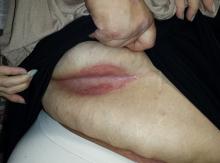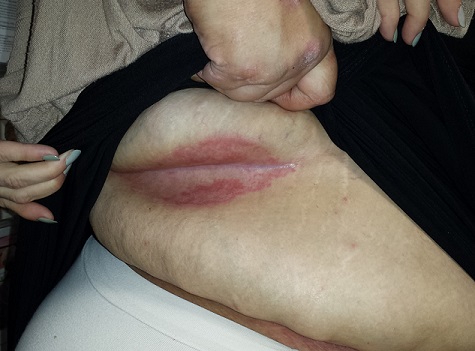User login
Since early summer, a 51-year-old woman has had an itchy rash on her trunk. It manifested after she intentionally lost more than 200 lb, which resulted in deeper and more pronounced skinfolds. The same skinfolds are repeatedly involved in flares of the rash, which is worse on particularly hot days. She was diagnosed with “yeast infection” but the problem failed to respond to oral fluconazole and topical nystatin.
The patient has multiple health problems, including diabetes, chronic anxiety, and hypertension.
EXAMINATION
There is a deep, linear, concave fold in the skin of the right flank, the long axis of which is transversely oriented. Within this fold, a fiery red rash is seen; its margins exactly match the outline of skin-on-skin contact. The surface of the affected skin is macerated and wet looking. There is neither tenderness nor increased warmth on palpation.
What is the diagnosis?
DISCUSSION
This phenomenon is called intertrigo, and it’s a subject of much confusion. This is especially true in primary care, where almost any intertriginous rash is labeled “yeast infection” and treated with anti-yeast medications that fail as monotherapy. In fact, true yeast infections in or on the skin are quite unusual.
Here is what happens when skin is held on skin: Moisture can accumulate, temperature rises, and skin becomes macerated and starts to break down. Organisms already present on the skin begin to multiply and can contribute to the inflammatory burden. Any pre-existing skin disease (eg, seborrhea, eczema or psoriasis) can flare under these conditions, further breaking down the epidermal barrier. With the right mix of these and other factors (severe obesity, diabetes, immunosuppression, hot weather), yeast can play a bigger role in the problem—but it is usually a minor factor.
Intertrigo is common under the breasts, in the axillae, and in abdominal panniculi. It can also be seen, as in this case, in large folds on the trunk, or even on the legs. Most cases of diaper rash involve at least a component of intertrigo.
The factors that predispose to intertrigo tend to be chronic, making the problem chronic as well. The patient and family (if appropriate) need to understand this, as well as the seasonal effects (the condition will be worse in warm months but improve in winter).
Treatment should be directed at reducing moisture in the area. This can be achieved by opening it up to air as much as possible, using aluminum acetate solution soaks to dry out the skin, placing strips of cotton or linen cloth to separate skinfolds, or applying antiperspirants or talcum-based powder.
For acute treatment, class 4 or 5 steroid creams can be used for short periods. An OTC topical anti-yeast cream, such as clotrimazole or miconazole, can be added.
The onset of such a rash, without obvious predisposing factors, should prompt consideration of other items in the differential. These include cutaneous T-cell lymphoma, Paget’s disease, or zinc deficiency–related conditions. More common lookalikes include contact or irritant dermatitis.
TAKE-HOME LEARNING POINTS
• As its name suggests, intertrigo is a condition affecting the intertriginous areas (eg, skin folds); common locations are under breasts or in the axillae, groin, or panniculi.
• Though yeast organisms can play a role in the development of intertrigo, treatment with anti-yeast products as monotherapy rarely work.
• Instead, management of intertrigo must be directed at the causative factors: heat, sweat, and friction.
• Intertrigo is difficult to treat, in large part because the major causative factors (weight, heat, sweat) are hard to change.
Since early summer, a 51-year-old woman has had an itchy rash on her trunk. It manifested after she intentionally lost more than 200 lb, which resulted in deeper and more pronounced skinfolds. The same skinfolds are repeatedly involved in flares of the rash, which is worse on particularly hot days. She was diagnosed with “yeast infection” but the problem failed to respond to oral fluconazole and topical nystatin.
The patient has multiple health problems, including diabetes, chronic anxiety, and hypertension.
EXAMINATION
There is a deep, linear, concave fold in the skin of the right flank, the long axis of which is transversely oriented. Within this fold, a fiery red rash is seen; its margins exactly match the outline of skin-on-skin contact. The surface of the affected skin is macerated and wet looking. There is neither tenderness nor increased warmth on palpation.
What is the diagnosis?
DISCUSSION
This phenomenon is called intertrigo, and it’s a subject of much confusion. This is especially true in primary care, where almost any intertriginous rash is labeled “yeast infection” and treated with anti-yeast medications that fail as monotherapy. In fact, true yeast infections in or on the skin are quite unusual.
Here is what happens when skin is held on skin: Moisture can accumulate, temperature rises, and skin becomes macerated and starts to break down. Organisms already present on the skin begin to multiply and can contribute to the inflammatory burden. Any pre-existing skin disease (eg, seborrhea, eczema or psoriasis) can flare under these conditions, further breaking down the epidermal barrier. With the right mix of these and other factors (severe obesity, diabetes, immunosuppression, hot weather), yeast can play a bigger role in the problem—but it is usually a minor factor.
Intertrigo is common under the breasts, in the axillae, and in abdominal panniculi. It can also be seen, as in this case, in large folds on the trunk, or even on the legs. Most cases of diaper rash involve at least a component of intertrigo.
The factors that predispose to intertrigo tend to be chronic, making the problem chronic as well. The patient and family (if appropriate) need to understand this, as well as the seasonal effects (the condition will be worse in warm months but improve in winter).
Treatment should be directed at reducing moisture in the area. This can be achieved by opening it up to air as much as possible, using aluminum acetate solution soaks to dry out the skin, placing strips of cotton or linen cloth to separate skinfolds, or applying antiperspirants or talcum-based powder.
For acute treatment, class 4 or 5 steroid creams can be used for short periods. An OTC topical anti-yeast cream, such as clotrimazole or miconazole, can be added.
The onset of such a rash, without obvious predisposing factors, should prompt consideration of other items in the differential. These include cutaneous T-cell lymphoma, Paget’s disease, or zinc deficiency–related conditions. More common lookalikes include contact or irritant dermatitis.
TAKE-HOME LEARNING POINTS
• As its name suggests, intertrigo is a condition affecting the intertriginous areas (eg, skin folds); common locations are under breasts or in the axillae, groin, or panniculi.
• Though yeast organisms can play a role in the development of intertrigo, treatment with anti-yeast products as monotherapy rarely work.
• Instead, management of intertrigo must be directed at the causative factors: heat, sweat, and friction.
• Intertrigo is difficult to treat, in large part because the major causative factors (weight, heat, sweat) are hard to change.
Since early summer, a 51-year-old woman has had an itchy rash on her trunk. It manifested after she intentionally lost more than 200 lb, which resulted in deeper and more pronounced skinfolds. The same skinfolds are repeatedly involved in flares of the rash, which is worse on particularly hot days. She was diagnosed with “yeast infection” but the problem failed to respond to oral fluconazole and topical nystatin.
The patient has multiple health problems, including diabetes, chronic anxiety, and hypertension.
EXAMINATION
There is a deep, linear, concave fold in the skin of the right flank, the long axis of which is transversely oriented. Within this fold, a fiery red rash is seen; its margins exactly match the outline of skin-on-skin contact. The surface of the affected skin is macerated and wet looking. There is neither tenderness nor increased warmth on palpation.
What is the diagnosis?
DISCUSSION
This phenomenon is called intertrigo, and it’s a subject of much confusion. This is especially true in primary care, where almost any intertriginous rash is labeled “yeast infection” and treated with anti-yeast medications that fail as monotherapy. In fact, true yeast infections in or on the skin are quite unusual.
Here is what happens when skin is held on skin: Moisture can accumulate, temperature rises, and skin becomes macerated and starts to break down. Organisms already present on the skin begin to multiply and can contribute to the inflammatory burden. Any pre-existing skin disease (eg, seborrhea, eczema or psoriasis) can flare under these conditions, further breaking down the epidermal barrier. With the right mix of these and other factors (severe obesity, diabetes, immunosuppression, hot weather), yeast can play a bigger role in the problem—but it is usually a minor factor.
Intertrigo is common under the breasts, in the axillae, and in abdominal panniculi. It can also be seen, as in this case, in large folds on the trunk, or even on the legs. Most cases of diaper rash involve at least a component of intertrigo.
The factors that predispose to intertrigo tend to be chronic, making the problem chronic as well. The patient and family (if appropriate) need to understand this, as well as the seasonal effects (the condition will be worse in warm months but improve in winter).
Treatment should be directed at reducing moisture in the area. This can be achieved by opening it up to air as much as possible, using aluminum acetate solution soaks to dry out the skin, placing strips of cotton or linen cloth to separate skinfolds, or applying antiperspirants or talcum-based powder.
For acute treatment, class 4 or 5 steroid creams can be used for short periods. An OTC topical anti-yeast cream, such as clotrimazole or miconazole, can be added.
The onset of such a rash, without obvious predisposing factors, should prompt consideration of other items in the differential. These include cutaneous T-cell lymphoma, Paget’s disease, or zinc deficiency–related conditions. More common lookalikes include contact or irritant dermatitis.
TAKE-HOME LEARNING POINTS
• As its name suggests, intertrigo is a condition affecting the intertriginous areas (eg, skin folds); common locations are under breasts or in the axillae, groin, or panniculi.
• Though yeast organisms can play a role in the development of intertrigo, treatment with anti-yeast products as monotherapy rarely work.
• Instead, management of intertrigo must be directed at the causative factors: heat, sweat, and friction.
• Intertrigo is difficult to treat, in large part because the major causative factors (weight, heat, sweat) are hard to change.

